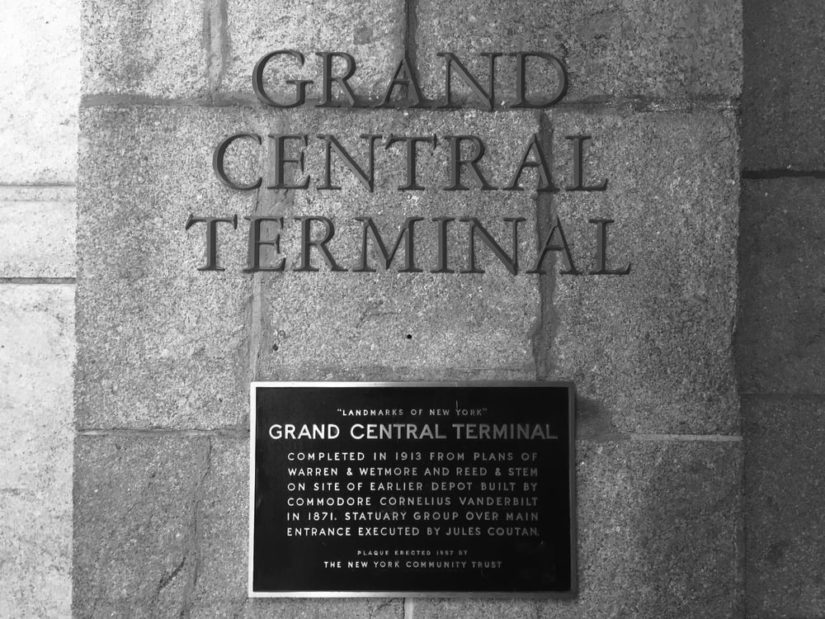
New York Community Trust Plaque Program
Also known as Landmarks of New York Plaque Program and Heritage of New York Plaque Program
Begun in 1957, the New York Community Trust Plaque Program raised awareness of landmarks’ history with public markers for important sites.
The New York Community Trust Plaque Program was a program created in 1957 when a committee of civic leaders designated twenty buildings as “Landmarks of New York” and dedicated aluminum plaques for the corresponding significant structures in New York City. This plaque program was originally the “brainchild” of Whitney North Seymour, Sr., who successfully secured a grant to fund the costs of research and materials.1 The program was sponsored by the New York Community Trust and guided by the Municipal Art Society to raise public awareness of the buildings’ historic and architectural value.
The committee’s initial designations were selected from New York Landmarks: An Index of Architecturally Historic Structures in New York City, the list of significant buildings compiled by the Municipal Art Society and the Society of Architectural Historians, and published in 1957.2 These first “landmarks” were the Bowery Savings Bank, Carnegie House, Central Synagogue, Church of the Ascension, Church of St. Paul the Apostle, Erasmus Hall, Grace Church, Grand Central Terminal, Guaranty Trust Co. Building, Metropolitan Life Building, New York Academy of Medicine, New York Daily News Building, New York Stock Exchange, 9 East 72nd Street, St. Paul’s Chapel, St. Thomas Church, (Former) Tiffany & Co. Stables, the Times Tower, the University Club, and the Woolworth Building.3
For a decade, the New York Community Trust designated and marked historic buildings as “Landmarks of New York.” These “landmarks,” were not protected, however. Buildings continued to be demolished and the need for legal protection of buildings grew more urgent.4 Thanks in part to the New York Community Trust Plaque Program and the advocacy surrounding the “landmarks,” civic and public support for preservation grew stronger.
Following the enactment of New York City’s Landmarks Law and the establishment of the Landmarks Preservation Commission as a regulatory agency, the New York Community Trust plaques’ title was changed to “Heritage of New York,” so as not to confuse those buildings recognized through the independent New York Community Trust program with official New York City landmarks designated and protected by the Landmarks Preservation Commission. In 1969, the Landmarks Preservation Commission assumed the responsibility for erecting the plaques on designated landmarks, though the New York Community Trust continued to fund the markers that now read “Designated Landmark—New York City.”5 In 1987, the New York Landmarks Preservation Foundation, headed by former Landmarks Commissioner Barbaralee Diamonstein, began funding the plaque program and pledged to mount bronze plaques recognizing every New York City landmark “whose owner would accept such a marker.”6
1957: The New York Community Trust Plaque Program is created
1969: The New York City Landmarks Preservation Commission assumes the responsibility for erecting the plaques on designated landmarks, but the New York Community Trust continued to fund the markers
1987: The New York Landmarks Preservation Foundation, headed by former Landmarks Commissioner Barbaralee Diamonstein, begins funding the plaque program
Predating New York City’s landmarks legislation, the New York Community Trust plaque program was intended to mark historically and architecturally significant sites. The Plaque Program originated under the influence of Whitney North Seymour, Sr., who was a member of the Trust's Distribution Committee. He helped secure funding in order for the plaque program to function.7
The New York Community Trust plaque program used the Municipal Art Society's list of historic buildings worthy of preservation and then placed plaques on the exterior of the buildings to commemorate the history. In addition, the funding helped pay for the costs of the plaques and helped "further develop its index of important structures."8 The establishment of this program in 1957 was a direct precursor to programs of both the New York City Landmarks Preservation Commission and the National Register of Historic Places. In addition to producing and erecting plaques, funding from the New York Community Trust made possible the Municipal Art Society’s continuing research and expansion of its register of historic places: New York Landmarks: An Index of Architecturally Historic Structures in New York City.9
The program generated much needed visibility for the buildings, many of which were endangered. As Whitney North Seymour, Sr. stated at the dedication of the first plaques, “it was high time that New Yorkers and visitors have some way to identify our historical and architectural treasures."10 The plaque program was one of many successful efforts, along with “exhibits, radio shows, walking tours, [and] publications,” made by the Municipal Art Society and other civic organizations that focused attention and educated the public on the built environment and the need for legal protection of New York City’s significant buildings.11
- Anthony C. Wood, Preserving New York: Winning the Right to Protect A City’s Landmarks (New York: Routledge, 2008), page 153.
- New York Community Trust, The Heritage of New York (New York: Fordham University Press, 1970), page xiv.
- Edith Evans Asbury, “Landmark Signs Dedicated Here: 20 Are First of Many That Will Mark Historical and Architectural Sites,” The New York Times, 22 November 1957, page 22.
- New York Community Trust, The Heritage of New York (New York: Fordham University Press, 1970), page xiii; Anthony C. Wood, Preserving New York: Winning the Right to Protect A City’s Landmarks (New York: Routledge, 2008), page 127.
- New York Community Trust, The Heritage of New York (New York: Fordham University Press, 1970), page xix.
- Ibid, page xix.
- Anthony C. Wood, Preserving New York: Winning the Right to Protect a City’s Landmarks (New York: Routledge, 2008), page 153.
- Ibid, page 155.
- Edith Evans Asbury, “Landmark Signs Dedicated Here: 20 Are First of Many That Will Mark Historical and Architectural Sites,” The New York Times, 22 November 1957, page 22.
- Anthony C. Wood, Preserving New York: Winning the Right to Protect a City’s Landmarks (New York: Routledge, 2008), page 155.
- Ibid, page 155.